Avez-vous déjà essayé de téléverser un fichier sur votre site WordPress et vous êtes heurté à un mur ? C’est très frustrant de ne pas pouvoir téléverser l’image, l’extension ou le thème dont vous avez besoin. Nos Lecteurs nous demandent souvent de l’aide pour les problèmes de téléversement de fichiers, car ils peuvent ralentir votre flux de travail.
Parfois, ces limites de téléversement de fichiers peuvent inopinément vous empêcher d’ajouter du contenu à votre médiathèque ou d’installer les plugins et thèmes plus volumineux dont vous avez besoin. C’est comme si vous étiez épinglé avec les mains liées. Et c’est encore plus ennuyeux lorsque vous ne savez pas comment corriger la situation !
Mais ne vous inquiétez pas, nous sommes là pour vous aider. Nous aimons que WordPress soit une plateforme si configurable, et il y a souvent plusieurs façons de résoudre le même problème.
Dans ce guide, nous allons vous afficher les moyens les plus simples pour augmenter la taille maximale de téléversement des fichiers dans WordPress. Nous allons vous permettre de dépasser ces limitations afin que vous puissiez retourner faire ce que vous aimez : gérer votre site !
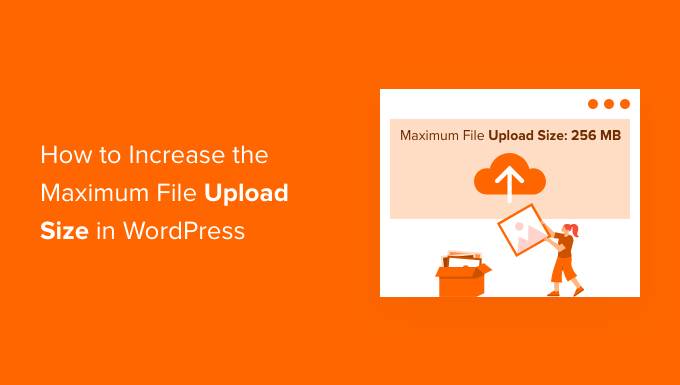
Pourquoi augmenter la taille maximale de l’outil téléversé dans WordPress ?
Votre fournisseur d’hébergement WordPress définira une taille maximale de téléversement de fichiers par défaut lorsque vous configurerez et installerez WordPress. Cette limite est définie par votre fournisseur d’hébergement et se situe généralement dans une plage de 2 Mo à 500 Mo.
Pour la plupart des propriétaires de sites WordPress, cette limite sera largement suffisante.
Cependant, il est parfois nécessaire d’augmenter cette limite afin d’éviter les erreurs de téléversement.
Par exemple :
- Vous gérez un site de photographie et devez téléverser des images de grande taille.
- Votre portfolio de design ou de photographie contient des images de grande taille.
- Vous souhaitez installer un thème ou une extension WordPress de plus grande envergure.
- Vous souhaitez vendre des produits numériques comme des eBooks, des photos, des vidéos, etc.
- Vous mettez régulièrement à jour le contenu et ajoutez de l’audio, des photos et d’autres éléments qui dépassent la limite actuelle.
Ceci étant dit, nous allons vous afficher comment vous pouvez augmenter la taille maximale de téléversement des fichiers sur votre site WordPress.
Note: Gardez à l’esprit que l’affichage d’un grand nombre de fichiers volumineux sur votre site peut sérieusement ralentir sa vitesse et ses performances. C’est pourquoi nous recommandons généralement de ne jamais téléverser de vidéos sur WordPress.
Comme la plupart des utilisateurs/utilisatrices ont des configurations d’hébergeurs WordPress différentes, nous aborderons les points suivants :
- How to Check Your Maximum File Upload Size Limit in WordPress
- Method 1: Contact Your WordPress Hosting Provider
- Method 2: Create or Edit an Existing php.ini file
- Method 3: Add Code to Your WordPress Theme functions.php File
- Method 4: Add Code to Your .htaccess File
- Method 5: Use a WordPress Plugin to Increase File Upload Size
Comment vérifier la taille maximale de votre outil de téléversement dans WordPress
WordPress affiche automatiquement la taille maximale de téléversement des fichiers lorsque vous téléversez des images ou d’autres médias.
Pour le vérifier, il vous suffit d’aller dans la rubrique ” Médias ” Ajouter nouveau dans votre panneau d’administration WordPress, et vous verrez la limite maximale de taille de téléversement de fichiers pour votre site WordPress.
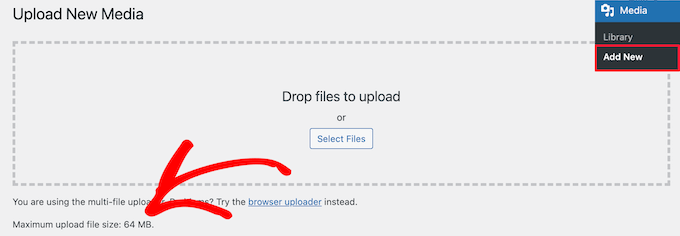
Maintenant que vous savez comment trouver la limite de taille, nous allons vous afficher comment augmenter la taille maximale de téléversement dans WordPress.
Méthode 1 : Contactez votre fournisseur d’hébergement WordPress
L’un des moyens les plus simples d’augmenter la taille maximale de téléversement des fichiers dans WordPress est de contacter votre fournisseur d’hébergement WordPress.
Il s’agit d’une tâche relativement simple pour leur équipe de service à la clientèle, qui peut être réalisée en quelques minutes.
Pour les débutants, cela peut être beaucoup plus facile que d’ajouter du code à WordPress et de modifier les fichiers du serveur.
Il vous suffit de vous rendre sur le site de votre fournisseur d’hébergement, comme Bluehost, et de vous connecter.
Cliquez ensuite sur l’icône ” Discussion ” qui se trouve en bas de l’écran. Vous pouvez alors demander au support d’augmenter la taille de téléversement des fichiers sur votre site WordPress.
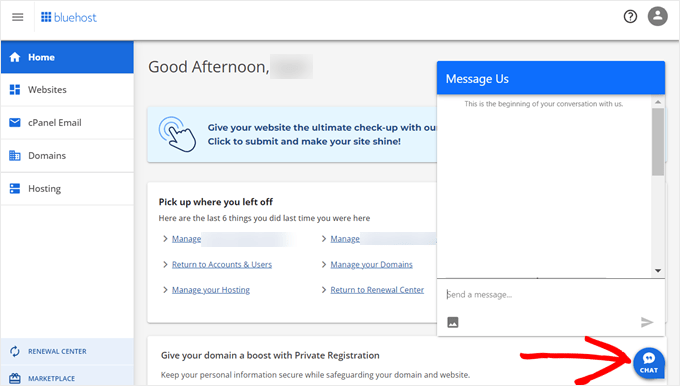
Vous pouvez également contacter le support depuis le tableau de bord de votre compte hébergeur.
Méthode 2 : Créer ou modifier un fichier php.ini existant
Une autre façon d’augmenter la taille maximale de téléversement des fichiers est de créer ou de modifier un fichier appelé php.ini. Ce fichier définit de nombreux réglages pour votre environnement d’hébergement WordPress.
La plupart des fournisseurs d’hébergement WordPress, comme Bluehost, disposent d’un cPanel convivial pour les débutants afin de vous aider à gérer votre site.
Si votre hébergeur dispose d’un tableau de bord cPanel, vous pouvez augmenter la taille de téléversement des fichiers grâce aux outils intégrés.
Note : Les informations suivantes proviennent du cPanel de Bluehost. Cependant, la plupart des fournisseurs d’hébergement mutualisé ont des étapes similaires.
Vous trouverez un bouton cPanel en bas de l’onglet Hébergement dans Bluehost.
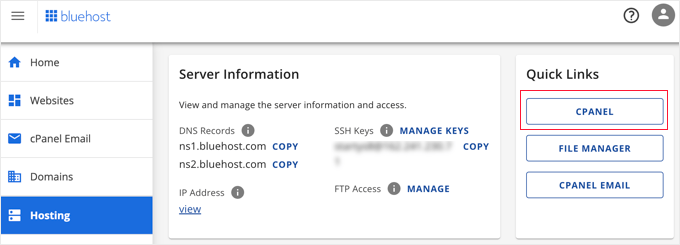
En cliquant sur ce bouton, vous ouvrirez votre Tableau de bord cPanel.
Vous devez maintenant défiler jusqu’à la section Logiciels et cliquer sur ‘MultiPHP INI Editor’.
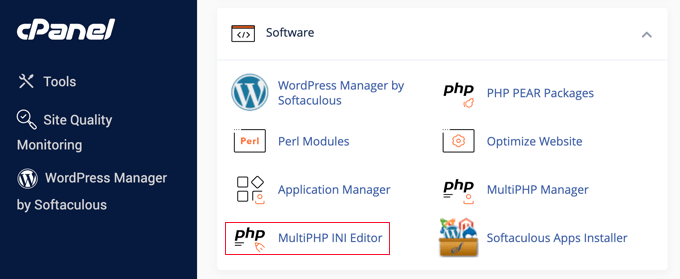
Ensuite, défilez vers le bas jusqu’à la section libellée “upload_max_filesize” et saisissez une nouvelle taille maximale de fichier dans la case.
Cliquez ensuite sur le bouton “Appliquer”.
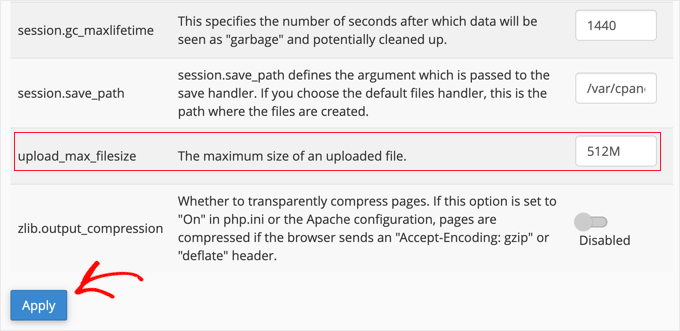
Vous pouvez également cliquer sur l’onglet de menu “Mode éditeur” et modifier la taille maximale de l’outil de téléversement directement dans l’éditeur.
Vous devez modifier la section ‘upload_max_filesize’ pour augmenter la taille de téléversement de vos fichiers.
Une fois que vous avez terminé, cliquez sur le bouton “Enregistrer”.
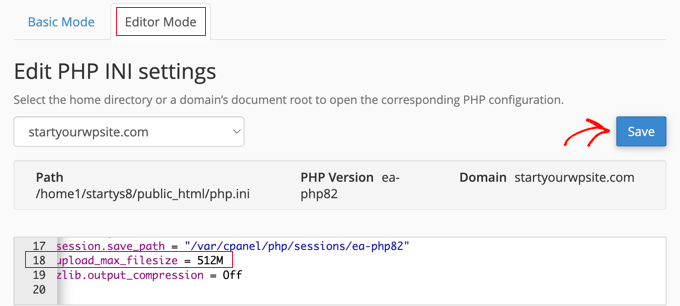
Modifier le php.ini en y ajoutant du code
Si votre fournisseur d’hébergement actuel ne propose pas l’option cPanel, vous devrez modifier ce fichier manuellement.
Pour ce faire, vous pouvez utiliser un client FTP ou l’option du gestionnaire de fichiers dans le panneau de contrôle de votre hébergeur WordPress.
Si vous utilisez un hébergeur mutualisé, il se peut que vous ne voyiez pas le fichier php.ini dans votre répertoire d’hébergement. Si ce n’est pas le cas, créez simplement un fichier nommé php.ini et téléversez-le dans votre dossier racine.
Ajoutez ensuite l’extrait de code suivant au fichier :
1 2 3 | upload_max_filesize = 256Mpost_max_size = 256Mmax_execution_time = 300 |
Vous pouvez modifier la limite de “256M” en fonction de la taille de fichier dont vous avez besoin pour votre blog WordPress.
Méthode 3 : Ajouter du code au fichier functions.php de votre thème WordPress
Cette méthode consiste à ajouter du code au fichier functions.php de votre thème WordPress.
Au lieu de modifier le fichier directement, nous vous recommandons d’utiliser WPCode. C’est la meilleure extension d’extraits de code qui vous permet d’ajouter du code à votre site sans le casser.
Si vous ne l’avez jamais fait auparavant, consultez notre guide du débutant sur la façon d’ajouter un module personnalisé dans WordPress.
Tout d’abord, vous devez installer l’extension gratuite WPCode. Pour plus de détails, consultez notre guide étape par étape sur l’installation d’une extension WordPress.
Une fois activé, vous devez naviguer jusqu’à Extraits de code ” + Ajouter un extrait.
Vous devez survoler l’option “Ajouter votre code personnalisé (nouvel extrait)”, puis cliquer sur le bouton “+ Ajouter un extrait personnalisé”.

Ensuite, vous devez choisir “PHP extrait de code” comme type de code dans la liste d’options qui apparaît.

Dans l’écran suivant, saisissez un nom pour votre nouvel extrait, qui peut être n’importe quoi pour vous aider à vous rappeler à quoi sert le code.
Ensuite, vous pouvez copier et coller l’extrait de code suivant sous “Prévisualisation du code”. Confirmez vos modifications en remplaçant “256M” par la taille maximale du fichier dont vous avez besoin :
1 2 3 | @ini_set( 'upload_max_size' , '256M' );@ini_set( 'post_max_size', '256M');@ini_set( 'max_execution_time', '300' ); |
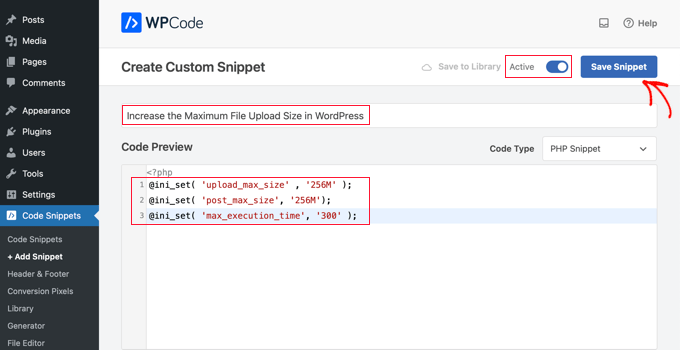
Enfin, mettez le permuter en haut sur “Actif” et cliquez sur le bouton “Enregistrer l’extrait”. Le code sera maintenant exécuté sur votre site.
Méthode 4 : Ajouter du code à votre fichier .htaccess
Un autre moyen d’augmenter la taille maximale des fichiers consiste à modifier le fichier .htaccess. Ce fichier contrôle les paramètres de configuration de haut niveau de votre site.
Pour ce faire, vous devez vous connecter au serveur de votre site via FTP. Si vous n’avez jamais fait cela auparavant, consultez notre guide sur l’utilisation de FTP pour téléverser des fichiers sur WordPress pour les débutants.
Ensuite, vous devez localiser votre fichier .htaccess dans le dossier racine de votre site.

Si vous ne trouvez pas votre fichier .htaccess, c’est qu’il est peut-être masqué par votre gestionnaire de fichiers ou votre client FTP. Pour en savoir plus, consultez notre guide sur les raisons pour lesquelles vous ne trouvez pas le fichier .htaccess sur votre site WordPress.
Ensuite, vous devez ajouter l’extrait de code suivant à votre fichier .htaccess :
1 2 3 4 | php_value upload_max_filesize 256Mphp_value post_max_size 256Mphp_value max_execution_time 300php_value max_input_time 300 |
Pour augmenter encore la taille maximale de votre outil téléversé, il vous suffit de modifier la valeur “64M” en fonction de la taille nécessaire.
Méthode 5 : Utiliser une extension WordPress pour augmenter la taille du téléversement des fichiers
Une autre façon d’augmenter la limite maximale de téléversement de fichiers est d’utiliser l’extension WP Increase Upload Filesize. Si vous n’êtes pas à l’aise avec l’ajout de code sur WordPress, cette option pourrait vous convenir.
La première chose à faire est d’installer et d’activer l’extension. Pour plus de détails, consultez notre guide sur l’installation d’une extension WordPress.
Une fois activé, naviguez vers ” Médias ” Augmenter la limite de téléversement dans votre panneau d’administration WordPress.
Vous accédez à un écran dans lequel vous pouvez sélectionner une nouvelle taille de téléversement dans le menu déroulant “Choisissez la taille maximale de l’outil de téléversement”.
Cliquez ensuite sur le bouton “Enregistrer les modifications”.

Note : La taille maximale de l’outil téléversé est définie par votre fournisseur d’hébergement. Si vous avez besoin d’une taille de fichier supérieure à celle indiquée dans la liste déroulante, vous devez contacter votre fournisseur d’hébergement et lui demander d’augmenter la limite.
Tutoriel vidéo
Si vous n’aimez pas suivre des instructions écrites, vous pouvez consulter notre tutoriel vidéo :
Nous espérons que cet article vous a aidé à augmenter la taille maximale de téléversement des fichiers dans WordPress. Vous pouvez également consulter notre guide sur la façon d’ajouter des types de fichiers supplémentaires à téléverser dans WordPress et nos choix d’experts de plugins et d’astuces pour améliorer la zone d’administration de WordPress.
Si vous avez aimé cet article, veuillez alors vous abonner à notre chaîne YouTube pour obtenir des tutoriels vidéo sur WordPress. Vous pouvez également nous trouver sur Twitter et Facebook.





Sushil Kumar
Thank you Yasir Imran it works for me via .htaccess
Pedro Viana
.htaccess rules! thanks.
Amit Kumar Gupta
Very useful Article for me . Thanks wpbeginner
Steve S
I figured out a work-around that does not involve messing with php.ini, .htaccess, functions.php, or any other systtem files. All I did was the following:
* FTP the file up to /wp-content/uploads/year/month/filename.mp4
* New Post –> Add Media –> Insert from URL
* Cut and paste the appropriate URL based on where you uploaded the file.
* Hit Insert Into Post. Done.
kenny
Perfect! ps if you are inserting an image for a slide background in slider Revolution, use option ‘External URL’
vic
the .htaccess worked fine for me. thanks alot
Anchal Singh
my website have got the same issue but thanks to this post its now work perfect
Matt
Thanks. I want to also know how to make a website portal using wordpress. Any information from you will be highly appreciated.
marta
Thanks. For me htaccess Method did his job
Rifqi Arief
Thanks Bro, Its Work On My Free Hosting via .htacess
RT
Please try below steps as well after creating the php.ini
(1) Go to My Sites -> Network Admin -> Settings from WordPress admin dashboard.
(2) Uncheck the checkbox for “Site upload space: Limit total size of files uploaded to 10 MB” and Save changes.
(3) Done.
Regards,
-RT
Suika
Thanks, I forgot there was a setting there for that.
Abhishek
I’m on goddady hosting, none of the 3 solutions worked for me.
But some users reported .user.ini file worked for them in goddady.
can anybody tell me where to put this file?
I have tried root folder and wp-admin folder nothing worked.
Raman Gutyan
htaccess Method is working great in my localhost.
Thanks for sharing.
DVR
If you are hitting a wall. Go to your host. Advance setting for PHP. Scan the code looking for max upload & file size. Change it to your required setting.
Done.
See NICOLAS’ reply above.
martin kendall
Hi DVR I had tried everything and nothing worked, with what had been posted here. I tried multi times in every why to get it to work. Nothing, but your post put me on the correct answer. Thanks very much for that.
Ok this is what i did, Signed into my host server, where my website is. the host server runs on cPanel and the theme is paper_lantern. It should not matter what your sever is or the theme. If you do not have access to this area you will have to get your host to make the changes y cotacting your technical help.
In the panel you will have categories like = files, database, domains, email etc and what you are looking for is software, under software / apps look for multiPHP INI Editor or something like that. Its going to be different on other platforms but should be in that area. What you are looking for is configure PHP INI basic settings or editor mode. I got offered home directory or my domain name. I picked the domain name but maybe need to change both but I did not need to. Scrolled down to upload_max_filesize and changed to 64M but this did not work as you have to also change the momory_limit to 64M also. They have to be the same figure. and then it will work.
Has I understand, when you make the changes in wordpress code. the instruction talk to your data base through the PHP files and instruct the server software to change the database settings. For some reason It would not work for me. So this route, bypass that and making the changes on the server software and not on the wordpress software. In future I will go this way as it was really quick. I hope this helps as a last resort. Martin p.s. this was WordPress 4.8.1 and I found that it did not have, after loading it any PHP.INI or .htaccess files. I did install them but made no difference and or where I put them.
Jeet Patel
THank you so much it’s working really
Silentnight
Thank u so much… I increased my uploading size.
Gopi krishnan
For me, this is not working, but i did this in htaccess file in this way,
php_value post_max_size 10M
php_value upload_max_filesize 40M
php_value memory_limit 500M
This works !
agnieszka00
Thank you!!!!!
Michael Serovey
I have my websites hosted with GoDaddy and so far, NONE of the above suggestions have worked! I have paid for this plugin and now I that I wasted my money!
Paul
Hi,
To avoid the plugin upload limit you can just upload the plugin with filezilla to your plugin directory. After uploading you can extract the zip file in the file manager and after you have done this the plugin is visible and ready to activate in your admin –> plugin panel
Hope this helped.
Cheers
Pooya
WOW! THANK YOU PAUL!!
This worked perfectly for me!
and it is MUCH easier and more reliable than any of those methods.
just go to File Directory under the cPanel -> Public-html -> [ you site folder] -> wp-content ->themes or plugins
Then upload the zip file here and extract it.
login to your wp-admin dashboard. and bam, you got yourself the theme or plugin.
Tom
Thank the Lord (paul) this took way too long.
Nicolas
Just go to your hosting control pannel -> Advanced -> PHP Settings -> upload_max_filesize ( it usually is on 2M you can change it up to 8M in my case… the point is that it shouldn’t be higher than your post_max_size)
You are welcome!
Jake
Best answer yet.
Steven Gliebe
functions.php is not the best place to put the code because raising the PHP max upload size limit is unrelated to a specific theme. Users shouldn’t be changing theme files directly anyway. wp-config.php is probably a better place. The .htaccess or php.ini method is even better (or just ask the host).
Stephanie
php.ini needs to be in wp-admin folder. This article states it needs to be in the root, which I tried but it made no difference. FYI
Thank you for the information!
Aaron
Thanks so much for your reply Stephanie. Your information was exactly what I needed.
Mike Serovey
So far, NONE of the above suggestions have worked. My control panel does NOT allow me to change the PHP Settings, modifying the .htaccess created an internal server error and modifying the theme failed to work as well. Have any other suggestions?
Mike Serovey
With GoDaddy hosting, I discovered that I needed to use the lines of code that someone posted for the .user.ini file and then refresh my browser and recheck the plugin about three times each before the thing FINALLY worked!
Robert
Thank you! ini file need to be uploaded in wp-admin folder.
Emmanuel Parbey
Thank you.
It worked perfectly.
Somnath
@Stephnie Thanks a Lot .It Workz
Sorin
In wp-admin put php.ini and work
Angel Rodriguez
This worked for me as well.
shemmy
thanks ..this works fine
Prabhat
yes this is helpfull
Matt
Worked Immediately! Thanks! By the way if anyone else wants to know, my host is BlueHost and I am using a Genesis Theme.
Panagiotis Sakalakis
Using the .htaccess I got an Internal Error, and then I just removed the code and it fixed. After that, I created a php.ini file in /public_html/wp-admin, pasted the code and saved it. Everything’s work like a charm now and I can upload my files just fine without any problem.
Umesh Shejole
Yes, Useful……
Subin Babukuttan
htaccess worked fine .thanks 4 d post
hol
Hi
Does anyone know why if the PHP.INI file is changed as mentioned why when the file has completed to 100% nothing happens and it displays http error.
I can upload small files and small videos.
I cant upload anything bigger than say 200mb
I had this working and accepting larger files then I had a restore done on website.
I have changed the PHP.INI…
Is there any reason why just large files don’t work ?
do I need to edit the hta.access file ?
thanks
Ian
.htaccess method worked for Media Temple grid hosting, others didnt affect it, just in case anyones wondering…
Jay
IF YOUR STILL FINDING NOTHING IS WORKING..
(In my case the problem was with WP MULTISITES)..,
FIRST CHECK THE FOLLOWING:
1. check your hosting limits (although this was not my problem) make sure your hosting allows the limit you are trying to set ie if on a shared hosting you might find the maximum is 64M.
NOTE: The following solution may also apply If in WordPress, Maximum upload file size will not change even when changed in the php.ini file etc.
The 1M max upload problem lies with WP MULTISITES default settings!!
To change this, do the following to change the Maximum upload file size within WP admin:
LOG INTO YOUR ADMIN DASHBOARD:
1. At the top, hover over My Sites and then click Network Admin.
2. At the left, hover over Settings and then click Network Settings.
3. Scroll to the bottom of the page and change the Max upload file size to whatever you would like in KB.
4. Click Save Changes.
Hope this helps
Gregg
YESSSS. Thank yo sir.
Milton
Thanks Jay you were right on point for WP multisites
Denis
Worked for me. The site used to work and I couldn’t understand why it didn’t anymore. It was my conversion to multisite which caused the ptoblem.
Sam
Amazing!!! This works!
Adam
Thanks!!!! Jeez there’s not much help on the changes mutli-site makes!
Bhanu uday
It worked like a charm. Thank you very much.
AmanDeep Singh
Working !.I use Create or Edit an existing PHP.INI file method and after applying the settings as mentioned in the article now i am able to upload themes and plugins which are large in size.Thanks for sharing solution.
Judy
I am new to WordPress, I usually use Joomla but I have a new client that wants a WordPress site. When trying to upload images the WordPress message was that the file limit was 3Mb. I spent hours searching websites for an answer. I am using WAMP and localhost to create the site. Through localhost phpinfo() I could verify which php.ini was active, the one in Apache. I had a file limit of 64Mb but still WordPress had a 3Mb limit. This site gave the instructions under #3 to edit the .htaccess file in the WordPress folder. I copied and pasted the text into this file and IT WORKED! Thank you wpbeginner.
KenSanDiego
forgot to mention, my WP site is in a subdirectory with a domain pointer. Powweb’s php applies to everything in all subdirectories. So if you have any installations in subdirectories the change applies to all installations.
Ugyen Zangmo
Create php.ini in wp-admin folder
In the file put the following 3 lines:
upload_max_filesize = 2048M
post_max_size = 2048M
max_execution_time = 3000
Goto to your website as admin and check the upload new media page, it should now display Maximum upload file size: 2 GB.
Thanks to Yasir Imran for sharing your tip!
This worked for me. Thank you James for sharing the Yasir Imran tip. Cheers
sadiq
it is not working i have done same
in godaddy server
Raton Miah
working!
Brendan
That was a great tip… it worked for me.. thanks!
Ben
Holy crap! Thanks so much man, after the last wordpress update to 4.3.1 my upload size reverted back to the default of 50 MB even though my php.ini, .htaccess, and wp-config.php files hadn’t changed and were still reflecting a max upload size of 512 MB! You’re a hero!
Alain
Thank you very much!
I tried ALL of the three methods with no results.
I asked the webhost and the raised the limit to 40 MB.
Then, finally, I tried yours and it worked fantastically!
dominio público
post_max_size should be larger than upload_max_filesize to allow room for other information. The defaults are 2MB max file size and 8MB max post size.
From PHP’s documentation:
post_max_size integer
Sets max size of post data allowed. This setting also affects file upload. To upload large files, this value must be larger than upload_max_filesize.
Nori
Thanks for this! Tried the php.ini and I am quite surprised it worked and was so easy
Dan
php.ini file worked perfectly for me. I simply changed the existing values to 100M. All good. Thanks for the advice.
James
Create php.ini in wp-admin folder
In the file put the following 3 lines:
upload_max_filesize = 2048M
post_max_size = 2048M
max_execution_time = 3000
Goto to your website as admin and check the upload new media page, it should now display Maximum upload file size: 2 GB.
Thanks to Yasir Imran for sharing your tip!
Zain
Hy,
Please tell me the names of best themes for softwares/download sites?
i am waiting.
Thanks,
Zain.
Markus Aurelius
Nothing of the above worked for me on GoDaddy so I had to use .user.ini instead of php.ini and that worked fine. Thanks for pointing me in the right direction!
Keith
Thank you so much. I am on GoDaddy and this worked whereas several other methods did not.
Raj Kothari
Hi Keith, can you tell me under which folder you have put this file? .user.ini
Need help
Oliver
Thanks .user.ini worked for me on Godaddy
sam
1:- open “C:wampbinapacheapache2.4.9bin” folder and find “php” which is a configuration file and open it in ur notepad and again find “upload_max_filesize” and “post_max_size” and change both and save.
2:- open “C:wampbinphpphp5.5.12” folder and find “php” and “phpforapache” which are configuration file and open both in ur notepad and again find “upload_max_filesize” and “post_max_size” and change both and save.
3:- finally restart all services of wamp and enjoy…lov u all
Decb
Hi Guys, I’m REALLY new to this but can you look at what I see when I click to edit the .htaccess file – where do i add the code? at the start? at the end? Do I put my cursor at the begining and click return (then put it in) ??? Please help
Gerard ONeill
Deb, it wouldn’t matter where you added it; but make sure its outside of a block. To be safe, just add it at the end.
However, the better way (as of php5.5) is to modify the .user.ini file in a per directory basis. If you did the top level directory, it would apply to all sub directories (unless overridden).
http://php.net/manual/en/configuration.file.per-user.php
And obviously the system wide php.ini works too.
BenPDX
+1 for Alex’s solution. Upload php.ini folder to wp-admin folder worked for me on Lithium Hosting. 30 second Google search and 1 min to create text file and upload to server!
Dede Erik
I choice the third method and this is worked to me, thanks so much
Hasan Tareq
.htaccess works for my wpenigne site
Vineesh
Hi alex, you are right. php.ini file should be added to wp-admin folder. It will work perfectly…. thanks alex
Rafael
Just adding the php.ini file into wp admin folder worked perfectly!!! thanks!
chandan
thnx alot Alex this worked for me to..
Tony_atf
I keep getting http error even with your suggestion. im on godaddy I have filesize 300m but anything over 150Mb chokes. it uploads, sits for a few seconds and then the http error displays. wordpress never shows the error.
SunnyK
same with me. did you found any solution yet?
WPBeginner Staff
You can connect to your website using an FTP client and undo the changes you made.
Nitesh Magan
Hey I added the 1st code to my theme function file, but now everything on my site went blank. I cant even access my wp-admin of my site !!
Please Help …
Chris
If you’re just trying to upload files yourself in the admin panel (media), make a new plain text document, save it as whatever name (including extension) of the large file you’re trying to upload. So if you’re trying to upload “files.zip,” save a blank text document as files.zip. Upload this blank text file you just created in WordPress. Then, go to FTP or file manager, go to wp-content/uploads/(whatever year it is)/(whatever month it is). You should fine files.zip there. Delete that file (which is just a plain text file) then upload the real files.zip, making sure the names match up. Then when you go back to media it will be the right file.
Yasir Imran
I tried htaccess method and found 500 internal server error, then placed php.ini with 3 given lines in root directory, again didn’t work. Then I placed it in wp-admin folder and it worked. I think the author should mention it.
Alexandre
This worked for me while everything else had failed. Thanks for sharing.
Mel
I had the exact same experience and this worked for me. Thanks Yasir!
Les B
Thank you Yasir Imran…your method works where all others, including .htaccess fails!
(The php.ini must be in the wp-admin folder.)
Les